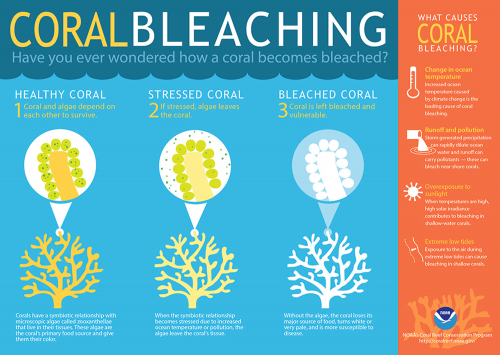BELIZE CITY, Thurs. Mar. 10, 2016–Belize’s majestic coral reef seascape is a cherished wonder that attracts nature lovers from home and abroad—but more than that, it is vital to the ecosystem diversity in this part of the Caribbean which serves as a pillar for many thriving industries, key among them being tourism and fisheries. A study released today indicates that Belize’s reef is being impacted by a third global coral-bleaching event.
Eli Romero, Conservation Officer for the Belize Audubon Society and chair of the National Coral Reef Network, conducted a monitoring study on coral bleaching in Belize, commissioned by the Healthy Reef Initiative, and he presented the preliminary results of that study at the Radisson today.
According to Romero, 25 sites were assessed in Belize between October and December 2015 as part of the Coral Bleaching Emergency Response monitoring plan, and it indicated that roughly 20% of sites in Belize are being affected to varying degrees, ranging from paling to full bleaching in at least a part of the coral colony.

Among those being impacted are Gallows Point, Goff’s Caye, Spanish Bank, South Snake Caye, Half Moon Caye, Northern Two Caye, Lighthouse Reef, and Laughing Bird Caye. Southern Belize was the most greatly impacted, possibly due to the additional stress caused by run-off from the mainland. The greater starlet coral (Siderastrea siderea) was found to be among the key species impacted.
In October 2015 the National Oceanic and Atmospheric Administration (NOAA), a US based organization, signaled that, “As record ocean temperatures cause widespread coral bleaching across Hawaii, NOAA scientists confirm the same stressful conditions are expanding to the Caribbean and may last into the new year, prompting the declaration of the third global coral-bleaching event ever on record.”
Mark Eakin, NOAA’s Coral Reef Watch coordinator, said that, “The coral bleaching and disease, brought on by climate change and coupled with events like the current El Niño, are the largest and most pervasive threats to coral reefs around the world.
Eakin said that huge areas of coral are being lost in the US, as well as internationally. The good news for our region is that the impact has not yet progressed to its worst stage—and there is hope that resilient corals could quickly spring back.
However, even as climate change and weather continue to impact the health of our reef, there is an even more concerning threat—land-based pollution which finds its way into the sea is adding even more stress to the marine ecosystem and causing those tiny algae, zooxanthellae—which give corals their beautifully radiant colors and which provide oxygen and essential nutrients which corals need to thrive—to be expelled from the corals. If the effects of coral bleaching are pronounced enough, corals could eventually die.
Dr. Melanic McField, Director of Healthy Reefs for Healthy People (Smithsonian Institution), said that the impact of bleaching along the network known as the Mesoamerican Reef was not as bad as the impacts felt when the phenomenon occurred in 1995—when Belize’s most pristine reefs were adversely impacted, and again in 1998—when they were worst hit. Whereas there was some coral death reported in the 1990s, none has been reported with this more recent bleaching phenomenon.
McField, who explained that simultaneous studies were conducted for Mexico, Honduras and Guatemala, noted that results were “not as bad for our region…” although the bleaching may end up being globally more significant than the previous events.
The data collected from the regional study will be used to support modeling by university researchers that could reveal where the most resilient corals are, she said. They could also help in the planning of mitigation measures to reduce other stresses, such as human sewage pollution, which can trigger diseases among corals, to which they would be even more susceptible during bleaching events.
The 2015/2016 bleaching event won’t be the last. “We have to be ready for the next one, because there will be more and more with climate change,” McField explained. While it is possible that some corals may begin to adapt, McField said that there is also the question of whether corals can keep up with the speed at which sea temperatures are changing due to climate change.

